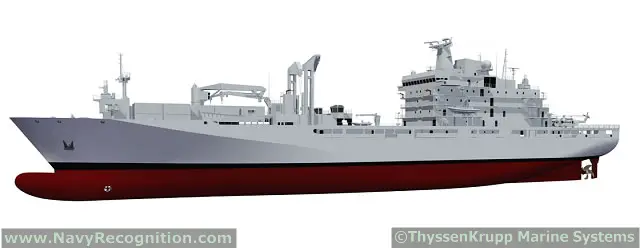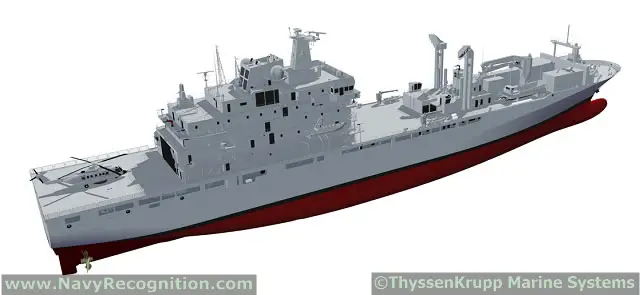Pointblank
Senior Member
ThyssenKrupp's Berlin Class AOR Design Selected As Canada's Next Supply Ship
The Berlin Class AOR's:

Nice ships. This news will be well received in the Vancouver marine industry. A number of related/supporting programs and activities have been held in juggling mode waiting for a decision.
Joint Support Ship Design Decision
BG–13.017 - June 2, 2013
The Government of Canada has selected a ship design for the Royal Canadian Navy’s future Joint Support Ships. This represents a major milestone within the Joint Support Ship project, and it is indicative of the Government’s commitment to moving the project forward, and to making an investment in Canadian shipbuilding.
The Selection and Process
Two ship designs were assessed to determine which would be right for the operations of the Royal Canadian Navy: a new design from BMT Fleet Technology and a proven off-the-shelf design by ThyssenKrupp Marine Systems Canada.
The selection of the design was conducted through a transparent and comprehensive process involving multiple government departments and third party advisors. The proven, off-the-shelf ship design from ThyssenKrupp Marine Systems Canada was selected as the best option. It offers the best overall combination of benefits. The assessment was based on three criteria: operational capability; affordability; and cost and schedule risks.
Operational capability: The main objective of the Joint Support Project is to renew the capabilities of the two current Auxiliary Oiler Replenishment Ships that are approaching the end of their service lives and need to be replaced. The Royal Canadian Navy is confident that the future Joint Support Ships will capably support deployed naval task groups and support operations ashore.
Affordability: The potential for variation in building costs is higher with a new design, and lower with a design that is known and has been built before. Therefore, cost estimates for building an existing design can be developed and refined with greater certainty. Between the two design options, the new design’s implementation costs are expected to be approximately 15 per cent more than the proven existing design. This means that only the existing design will allow the project to proceed with an acceptable rate of contingency funding.
Cost and schedule risks: The existing design has been proven both in build and operations. As the design was built and is operated by the German Navy, that experience reduces the risk of unexpected problems which would be associated with a new design.
In addition, construction cost estimates were validated by First Marine International, a firm of recognized experts in all areas of shipbuilding. Auditing firm KPMG reviewed the assessment methodology and monitored the process itself, as an independent third party.
The role of the Joint Support Ships
A Joint Support Ship increases the range and endurance of the Canadian Armed Forces by enabling naval task groups to stay at sea for long periods without obtaining provisions from ashore. The Joint Support Ships will supply deployed Naval Task Groups with fuel, ammunition, spare parts, food and water. They will also provide a home base for maintenance and operation of helicopters, a limited sealift capability, and support to operations ashore. Key distinctions of the selected design include the following:
Mission versatility: The Joint Support Ship will be based on an existing ship which was designed and built for operations as a support ship. It also offers the mission the flexibility and the ability to carry containerized payloads such as disaster relief supplies or portable headquarters for operations.
Environmental standards: The Joint Support Ship will meet current and forecasted international and Canadian environmental standards in the areas of air emissions and double-hulled construction. The PROTECTEUR-class currently is single-hulled and does not meet current shipbuilding standards.
Useable fuel: The selected design will have the ability to deliver a similar amount of useable fuel for the Task Group as the PROTECTEUR-class. While the PROTECTEUR-class has larger fuel capacity, it can not discharge its full payload without creating stability challenges.
Helicopter: The selected design option can carry two CH-148 Cyclone helicopters.
Next Steps
Once ThyssenKrupp Marine Systems Canada has prepared the design package, Canada will provide it to the Vancouver Shipyards Co. Ltd., for review. Once this review is completed, Canada will acquire the required license for the ship design. This license will enable Canada to use the ship design and build, operate, and maintain the Joint Support Ships – right here in Canada.
The design will be provided to Vancouver Shipyards Co. Ltd. to fully develop it to a production-ready state. This is a similar concept to developing detailed construction blue prints for a building from an architect’s plan. This design development work will be led by Vancouver Shipyards Co. Ltd., as part of the Joint Support Ship definition contract to be negotiated between the Government of Canada and the shipyard. This will further enhance the knowledge and technical skills among shipyard staff, to be leveraged for future work in the shipyard.
As the selected shipyard for non-combat vessels, Vancouver Shipyards will be responsible for the construction of all Joint Support Ships at their shipyard in North Vancouver, British Columbia. The design development contract will include the sourcing, by the shipyard, of all equipment and major services from available suppliers. Through this engagement Vancouver shipyards will be expected to demonstrate value to Canada including meeting its commitment to provide Industrial and Regional Benefits equal to 100 per cent of the value of the contract.
The Berlin Class AOR's:

Nice ships. This news will be well received in the Vancouver marine industry. A number of related/supporting programs and activities have been held in juggling mode waiting for a decision.





